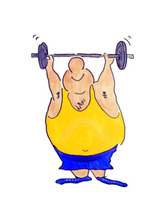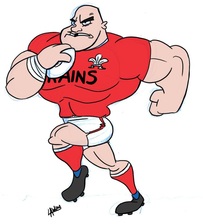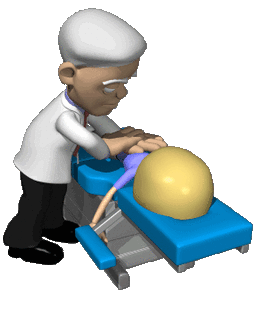 What better way to spend a wet, windy weekend than catching up on paperwork? And that's precisely what I've been doing - wrapped up in a snuggly jumper and armed with a large mug of tea. People always wonder what I'm up to when I'm not in clinic seeing patients, easing their back ache, stiff neck and sore muscles. Much as I would dearly love to be at home, pottering about the garden, playing with Twiglet (our rabbit) or running on the beach, the job of being a chiropractor and running the Llangefni Chiropractic Clinic seems to be somewhat never ending! Or maybe I'm just inefficient, or perhaps a workaholic?! One of the more time consuming activities is letter-writing. I like to communicate with each and every patient's GP (with the patient's permission, of course), to ensure that the GP is kept up to date with their chiropractic care. Obviously, there are also occasions when patients will require referral on to another healthcare professional for a second opinion. This letter writing also helps to build inter-professional relationships, and maintain the profile of chiropractic within the wider medical world. In addition to this there is the work involved with my position on the British Chiropractic Association Council, and the 'business' side of running a chiropractic clinic. Then the ongoing reading to keep up with latest research findings and catching up with old colleagues to discuss useful techniques - or just to have a gossip! So, that's probably why I'm finally getting around to writing this blog at 11pm, at the end of a productive rainy day. And yes, I did make sure I got up regularly for a wriggle and had a couple of walks, between the showers, for a bit of fresh air and exercise!
0 Comments
 None of us are getting any younger. That's something that we really can't do anything about; we can't stop the clock, or even slow it down. However, we can do something about it. I love the saying 'use it or lose it' and when it comes down to the body, that really is the case. This year, 2012, marks the 'European Year for Active Ageing'; an initiative set up by the European Union to recognise the increasing ageing population, and to raise awareness of the contribution that the older generation makes to society. The European Year encourages 'active ageing' with emphasis placed on the maintenance of good health and wellbeing, and an active, independent lifestyle, fully integrated and incorporated into the wider society. In recognition of this initiative, and as part of Chiropractic Awareness Week (16th to 20th April), we chiropractors have done a bit of consumer research*, the results of which highlight the need for action and attention, whatever your age, shape or size:
However, despite our concerns, we can do something about it! Like a car, or any well-oiled machine, keep the body moving gently on a daily basis and it'll generally keep going for longer. Remaining active as we grow older is vital for our overall wellbeing and continued health, and a few simple steps can be taken to help preserve your back and posture for years to come:
 Lunchbox, books, PE kit, favourite toy, homework file, left over sweets, forgotten letters from the teacher.... it's amazing all the junk that accumulates in a school bag. Just imagine what all that weight is doing to young backs! Up to 50% of kids have developed some form of back pain by the age of 14, says the National Back Pain Association. Its study also showed that 80% of children are carrying badly designed bags, or carrying them incorrectly - often slung over one shoulder which can distort the position of the upper back and shoulders, and cause the lower back and pelvis to twist. If your child has to lean forward while carrying their bag, or if the bag weighs more than 10 to 20% of their body weight, then it is too heavy for them and may cause problems, like back and neck pain, in the future. Follow this checklist to help reduce the risk of back pain in children:
 The Easter weekend is a time to relax, unwind, catch up with friends and family or tackle those DIY projects around the house and garden. Whatever you're up to, just be careful! Avoid neck and back pain, or those general aches and pains by following a few simple tips... 'How does your garden grow...?'
 I was chatting with a patient the other day; he had had an opportunity come his way that possibly could change the his life quite considerably and he didn't know what to do. I suggested that he should treat the opportunity like a rugby ball - sometimes life throws things at you unexpectedly. If you catch it, run with it as far and as fast as you can and you might just score a try. It you don't catch it, then at least you were in position, and ready. What you wouldn't do is just stand there and let the ball fall at your feet. I can't take the credit for this 'life philosophy' - that has to be handed to my late grandfather, a great sportsman, who likened life to rugby. I guess when you look at it, it isn't a bad analogy really. Life, like rugby, sometimes involves teamwork - the necessity to pull together and work as a unit with a common goal - but it also requires each and every individual member of that team to pull his own weight. Just like rugby, you need to train hard and practice, working through likely scenarios and occurrences so to have the best eventual outcome. And again, despite all the hours of practice, life, like rugby sometimes just doesn't go according to plan - just when you've got the ball, tucked firmly under your arm and you're running like the wind, Boom! - you'll get tackled. Your feet are knocked away from underneath you, leaving you winded and sprawling on the ground, gasping for air, and not quite sure where the move came from! However, after a couple of deep breaths you need to pick yourself up, dust yourself down and carry on with the game - you'll never score that try lying in a heap on the floor, or sitting it out nursing your knocks and bruises. Whilst simplistic, I find this analogy quite useful, particularly when I'm in a quandary and dithering over making a decision - I wonder if it's one of life's rugby balls and maybe I should just run with it and see how far I get. Or, when I've suffered one of life's tackles I try to drag myself back up and carry on the game, even if I am still smarting from the blow.  I'm always being asked 'what is the difference between a chiropractor and an osteopath?' My standard response is 'there are more similarities than differences; the training and teaching is very similar, the problems that we treat are the same, but the actual treatment methods and techniques may differ. It's a different way to skin a cat!' Having said which, there are huge variations within each profession and the technique used often depends on the individual practitioner (out of the myriad that they are taught!). There are some chiropractors who work in a very osteopathic way, and some osteopaths who work in a very chiropractic way! However, I've had a look at both professions and hopefully will provide a more thorough explanation... What do we study...? Both chiropractors and osteopaths undergo a 4 or 5 yr degree course at University and study all the basic biomedical sciences (anatomy, physiology, biochemistry, pathology, biomechanics, nutrition, pharmacology etc), together with the hands-on clinical stuff (physical examination, orthopaedics, neurology) and the various different treatment techniques (manipulation, mobilisation, soft tissue work, rehabilitation etc.) Students have to complete 2-3 years in the teaching clinic (real patients with real problems under supervision from clinicians) and complete a clinical research dissertation prior to graduating. On graduating, many of the associations require completion of a year-long Pre-Registration Training Scheme before they can be fully registered. There are several different Universities and Colleges in the UK that offer chiropractic or osteopathy, as well as those elsewhere in the world. All courses and colleges should be accredited with the appropriate educational and regulatory body. How are we regulated...? Both professions are regulated and protected in the UK by the General Chiropractic Council (GCC) or General Osteopathic Council (GOsC) respectively, who set and maintain the Code of Practice and Standards of Proficiency. Both regulatory bodies require all practitioners to register with them, and it is illegal to call yourself an osteopath or chiropractor, or to practise as one, if you are not on the appropriate Register. The GCC and GOsC require renewal of registration on an annual basis, and will check to see that the applicant has met the mandatory Continuing Professional Development (CPD) requirements, is in good health and good character, is in a 'fit state' to practise and has appropriate indemnity insurance. They can and do prosecute bad people, strike them off the register, or put restrictions of practise on them! In addition to this, individuals may join an association (eg the British Chiropractic Association, British Osteopathic Association). Each different association has its own membership criteria, (some more stringent than others, so may be a useful indicator in the 'quality' of the practitioner). The associations provide a number of different services and support for the practitioner, for instance indemnity insurance, business and clinical advice and legal support. The College of Chiropractors is another body; subdivided into regional and educational faculties, its primary role is the provision of postgraduate education, courses and seminars. Attendance at these can be used not only to meet the annual CPD requirements, but also to gain further post-graduate qualifications. So, what do we actually do...? Both chiropractors and osteopaths specialise in the diagnosis, treatment and management of conditions that affect the neuromusculoskeletal system and the affect that these may have on the overall health and wellbeing of the whole body. Both chiropractors and osteopaths use 'hands on' techniques (including manipulation, adjustment, mobilisation, soft tissue work, fascial release techniques, myofascial dry needling) to mobilise joints, ease muscle tension, reduce pain and restore neurological function. Most chiropractors and osteopaths will advise on rehabilitative exercises and stretches, posture and ergonomics, diet, nutrition and general exercise and lifestyle in order to promote recovery, prevent recurrence and improve overall health and wellbeing of the patient. Whilst traditionally thought of as just working on the spine (admittedly, we do tend to specialise in this!) both chiropractors and osteopaths treat the whole body. Hence, as well as treating problems affecting the neck, and low back pain we are proficient at treating problems affecting all the joints (including hip and knee pain, shoulder and elbow injuries, sports injuries, repetitive strain and over-use problems). Does it work and is it safe...? By taking a thorough medical and case history, and performing an extensive physical assessment, chiropractors and osteopaths are trained to pick up problems or complications that might prevent, or interfere with treatment. If this is the case, they are able to refer you on to the appropriate specialist, usually via your GP. The most appropriate type of treatment will be used for each individual patient, and techniques can be modified and adapted as necessary, so are safe and effective for people of all ages, shapes and sizes. The efficacy of chiropractic or osteopathy is supported in a number of peer-reviewed research studies, (particularly when assessing manipulation in the management of chronic or acute, low back or neck pain), but as in all areas of medicine we need more research! And, finally, which one's best...?! Both chiropractic and osteopathy are safe and effective in the management of problems with the muscles, joints and nerves. Both require a long period of initial and continued training, both are stringently regulated. As in any profession, regrettably there are unscrupulous individuals, and some practitioners may be better or worse than others. When advising whom to see, I always recommend that people should ensure that the practitioner is registered with their regulatory body, and ideally go with a 'word of mouth' recommendation from someone who has been a patient there before. At the end of the day, the appropriate qualified professional, whether chiropractor or osteopath, should be able to provide safe, professional, responsible and ethical care of patients. |
Ceri AnnEich Ceiropractydd yng Nghlinig Ceiropracteg Llangefnii Blogumulus by Roy Tanck and Amanda Fazani
Archives
June 2020
|
Llangefni Chiropractic Clinic, 6 GlanHwfa Rd, Llangefni LL777EN, Anglesey, North Wales, UK privacy policy Llangefni Chiropractic Clinic 2020
 RSS Feed
RSS Feed



